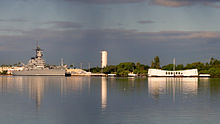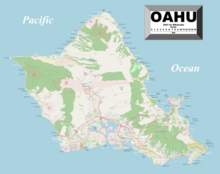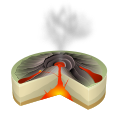|
Oahu
Oʻahu (pronounced /oˈʔɐhu/, /oʊˈɑːhuː/, sometimes written Oahu) is the third-largest and most populated island of the Hawaiian Islands and of the U.S. state of Hawaii.[1] The state capital, Honolulu, is on Oʻahu's southeast coast. The island of Oʻahu and the uninhabited Northwestern Hawaiian Islands[2] constitute the City and County of Honolulu. In 2021, Oʻahu had a population of 995,638,[3] up from 953,207 in 2010 (approximately 70% of the total 1,455,271 population of the Hawaiian Islands,[4] with approximately 81% of those living in or near the Honolulu urban area). Oʻahu is 44 miles (71 km) long and 30 miles (48 km) across. Its shoreline is 227 miles (365 km) long. Including small associated islands such as Ford Island plus those in Kāneʻohe Bay and off the eastern (windward) coast, its area is 596.7 square miles (1,545.4 km2), making it the 20th-largest island in the United States.[5] Well-known features of Oʻahu include Waikīkī, Pearl Harbor, Diamond Head, Hanauma Bay, Kāneʻohe Bay, Kailua Bay, and the North Shore. NameThe Island of Oʻahu in Hawaii is often nicknamed (or translated as) "The Gathering Place". The translation of "gathering place" was suggested as recently as 1922 by Hawaiian Almanac author Thomas Thrum. Thrum possibly ignored or misplaced the ʻokina because the Hawaiian phrase "ʻo ahu" could be translated as "gathering of objects" (ʻo is a subject marker and ahu means "to gather"). The term Oʻahu has no other confirmed meaning in Hawaiian.[6] History  It is uncertain when Oʻahu was first settled by humans. Early archaeological studies suggested that Polynesian explorers from the Marquesas may have arrived as early as the 3rd century A.D.,[7] possibly with a second wave arriving from Tahiti around 1100 A.D.[8] However, more modern analyses indicate that the first settlers probably arrived around 900–1200 A.D.[9] The first great king of Oʻahu was Maʻilikūkahi, the lawmaker, who initiated a 304-year dynasty of monarchs. Kualiʻi was the first of the warlike kings and was succeeded by his sons. In 1773, the throne fell upon Kahahana, the son of Elani of Ewa.[citation needed] On January 19, 1778, Oʻahu was the first of the Hawaiian Islands to be sighted by Captain James Cook during his third voyage of discovery.[10] This was the first recorded encounter of the Hawaiian Islands by non-Polynesian people. Cook bypassed Oʻahu, landing instead at Kauai before continuing his original mission to explore the coast of North America. The next year, on February 27, 1779, Cook's second in command, Captain Charles Clerke, became the first recorded non-Polynesian to visit Oʻahu when he landed at Waimea Bay. Earlier that month, Cook had been killed at Kealakekua Bay on the island of Hawaii when a dispute with the local people turned violent.[11] Clerke's visit to Oʻahu was brief and the expedition's two ships left Waimea Bay the same day after finding it difficult to obtain fresh water.[12] At the time of Cook's visit, the Hawaiian Islands were divided among several warring chiefdoms. In 1783, Kahekili II, king of the island of Maui, conquered Oʻahu. He then made his son, Kalanikūpule, king of Oʻahu turning it into a puppet state. Kalanikūpule was later defeated in the Battle of Nuʻuanu in 1795 by Kamehameha I who then founded the Kingdom of Hawaii. The Hawaiian islands were not fully unified until King Kaumualiʻi surrendered the islands of Kauai and Niihau in 1810.[13]: 29-60 By the late 18th century, Waikīkī was a major settlement on Oʻahu, serving as Kahekili II's residence after 1783.[13]: 34 However, as trade with foreigners intensified, the nearby town of Honolulu came to eclipse it in size and importance due to its more accessible harbor.[13]: 27 In 1845, Kamehameha III moved his capital to Honolulu from Lahaina on the island of Maui.[13]: 228 Later, King Kalākaua had a modern residence built in Honolulu for the royal family – the ʻIolani Palace which still stands as the only royal palace on American soil.[14] In January, 1893, a group of leading American businessmen took up arms near ʻIolani Palace and, along with US Marines from the USS Boston that landed in Honolulu harbor, launched a successful coup d'état against Queen Liliʻuokalani. The insurgents abolished the monarchy and established the Republic of Hawaii, which later successfully lobbied the US government for annexation to the US.[15] On the morning of December 7, 1941, the Imperial Japanese Navy launched a surprise attack on Pearl Harbor, Oʻahu, bringing the United States into World War II. The attack was aimed at destroying the American will to fight and forcing the US to sue for peace. They attacked the Pacific Fleet of the United States Navy and its defending Army Air Forces and Marine Air Forces. The attack damaged or destroyed 12 American warships, destroyed 188 aircraft, and killed 2,335 American servicemen and 68 civilians (of those, 1,177 were the result of the destruction of the USS Arizona alone).[16][17] After World War II, Oʻahu became a tourism and shopping destination with more than five million visitors per year, mainly from the contiguous United States and Japan.[18] Geography and climate Like all other Hawaiian Islands, Oʻahu was formed from the volcanism associated with the Hawaii hotspot; it started to grow from the sea floor 4 million years ago.[19] Today, the island is composed of the remnants of two extinct and extensively eroded shield volcanoes: the Waiʻanae and Koʻolau Ranges, with a broad valley or saddle between them.[20] The highest point is Kaʻala in the Waiʻanae Range, rising to 4,003 feet (1,220 m) above sea level.[21] Oʻahu is known for having the longest rain shower in recorded history. Kāneʻohe Ranch reported 247 straight days of rain from August 27, 1993, to April 30, 1994. The average temperature in Oʻahu is around 70–85 °F (21–29 °C). The island is the warmest from June through October. The winter is cooler, but still warm, with an average temperature of 68–78 °F (20–26 °C).
TourismOʻahu, along with the rest of the State of Hawaii, relies on tourism as a driving force of the local economy.[23] Popular tourists attractions include beaches such as Ala Moana Beach, Hanauma Bay, Kāneʻohe Bay, Ko Olina Beach Park, Waikīkī Beach, among others. Other tourist attractions include Ala Moana Center, Bishop Museum, the Honolulu Museum of Art, ʻIolani Palace, and Kualoa Ranch.
Notable people
See also
References
External linksInformation related to Oahu |
|||||||||||||||||||||||||||||||||||||||||||||||||||||||||||||||||||||||||||||||||||||||||||||||||||||||||||||||||||||||||||||||||||||||||||||||||||||||||||||||||||||













